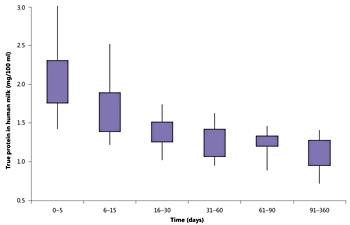What Do We Know about Protein Evolution of Breast Milk
Vevey, Switzerland
Vevey, Switzerland
- Human milk is a comprehensive source of nutrition for newborns.
- The composition of human milk is dynamic and evolves with time, imaginably, to adapt to the nutritional need of the infants.
- The concentration of protein in human milk follows a temporal pattern and decreases with progressing stages of lactation.
Human milk provides unparalleled nutrition to infants in early stages of life. Consequently, the WHO/UNICEF, the American Academy of Pediatrics and other similar organizations recommend exclusive breast-feeding for the first 6 months of life, with the introduction of complementary food at the age of 6 months and continuation of breast-feeding for as long as mutually agreeable by the mother and the infant [1, 2]. Human milk is a comprehensive source of energy, macronutrients as well as bioactive micronutrients essential for the growth and development of an infant, with possible exceptions of iron and vitamin D [3]. It is also a very dynamic fluid and may evolve with advancing stages of lactation to reflect the nutritional need of the growing infant. Various nutrients in human milk display such dynamism, and indeed protein fraction is one of them. We recently reviewed 34 publications and examined data on true protein in human milk at various lactation stages from 26 publications to highlight the evolution of proteins in human milk during the first year of life [4]. As evident from figure 1, there is a significant decrease in true protein in human milk from the very first week of lactation. The decline in the concentration of the protein continues to 6 months of life, after which it remains relatively constant. It is also noteworthy that during the early stages of lactation there is a high content of whey fraction in human milk compared to caseins (approximately 90:10 to 80:20) that transitions to 60:40 in transition milk and to 50:50 in mature milk [5, 6]. Additionally, colostrum protein is rich in immune and growth factors. Moreover, there are also multitudes of bioactive proteins in human milk, such as lactoferrin, lysozyme, secretory IgA, haptocorrin, α-lactalbumin, bile saltstimulated lipase, κ-casein, and β-casein [7]. Indeed, research over the past decades has given us insights into the dynamics of total and true protein in human milk; however, future research is required to understand the dynamics of bioactive proteins with advancing stages of lactation along with their contribution of biological activities at various stages of an infant’s growth.

- World Health Organization: Infant and young child nutrition. Geneva, WHO, 2003.
- American Academy of Pediatrics: Breastfeeding and the use of human milk. Section on breastfeeding. Pediatrics 2012;129:e827– e841.
- Denne SC: Neonatal nutrition. Pediatr Clin North Am 2015;62:427–438.
- Destaillats F, Erdmann P, Thakkar SK, Lönnerdal B: A developmental perspective of the contents of total protein and bioactive proteins in breast milk. In preparation.
- Kunz C, Lönnerdal B: Re-evaluation of the whey protein/casein ratio of human milk. Acta Paediatr 1992;81:107–112.
- Lönnerdal B: Nutritional and physiologic significance of human milk proteins. Am J Clin Nutr 2003;77:1537S–1543S.
- Lönnerdal B: Bioactive proteins in breast milk. J Paediatr Child Health 2013;49(suppl 1):1–7.
